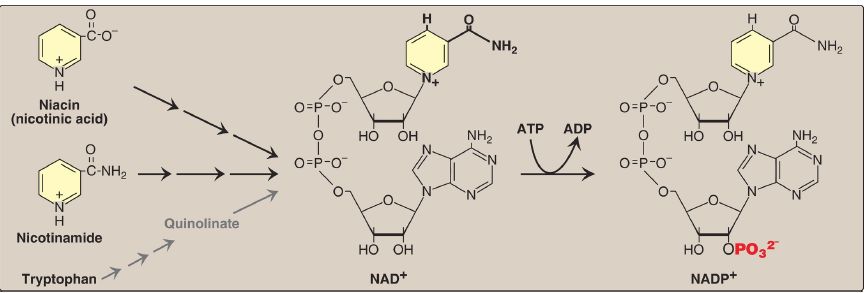


 النبات
النبات
 الحيوان
الحيوان
 الأحياء المجهرية
الأحياء المجهرية
 علم الأمراض
علم الأمراض
 التقانة الإحيائية
التقانة الإحيائية
 التقنية الحيوية المكروبية
التقنية الحيوية المكروبية
 التقنية الحياتية النانوية
التقنية الحياتية النانوية
 علم الأجنة
علم الأجنة
 الأحياء الجزيئي
الأحياء الجزيئي
 علم وظائف الأعضاء
علم وظائف الأعضاء
 الغدد
الغدد
 المضادات الحيوية
المضادات الحيوية|
Read More
Date: 1-9-2021
Date: 15-12-2021
Date: 1-11-2021
|
Niacin (Vitamin B3)
Niacin, or nicotinic acid, is a substituted pyridine derivative. The biologically active coenzyme forms are nicotinamide adenine dinucleotide (NAD+) and its phosphorylated derivative, nicotinamide adenine dinucleotide phosphate (NADP+), as shown in Figure 1. Nicotinamide, a derivative of nicotinic acid that contains an amide instead of a carboxyl group, also occurs in the diet.
Nicotinamide is readily deaminated in the body and, therefore, is nutritionally equivalent to nicotinic acid. NAD+ and NADP+ serve as coenzymes in oxidation–reduction reactions in which the coenzyme undergoes reduction of the pyridine ring by accepting two electrons from a hydride ion, as shown in Figure 2. The reduced forms of NAD+ and NADP+ are NADH and NADPH, respectively. [Note: A metabolite of tryptophan, quinolinate, can be converted to NAD(P). In comparison, 60 mg of tryptophan = 1 mg of niacin.]

Figure 1: Structure and biosynthesis of oxidized nicotinamide adenine dinucleotide (NAD+) and nicotinamide adenine dinucleotide phosphate (NADP+). ADP = adenosine diphosphate.
Figure 2: Reduction of oxidized nicotinamide adenine dinucleotide (NAD+) to NADH. [Note: The hydride ion consists of a hydrogen (H) atom plus an electron.] = phosphate.
A. Distribution
Niacin is found in unrefined and enriched grains and cereal, milk, and lean meats (especially liver).
B. Clinical indications for niacin
1. Deficiency: A deficiency of niacin causes pellagra, a disease involving the skin, gastrointestinal tract, and CNS. The symptoms of pellagra progress through the three Ds: dermatitis (photosensitive), diarrhea, and dementia. If untreated, death (a fourth D) occurs. Hartnup disorder, characterized by defective absorption of tryptophan, can result in pellagra-like symptoms. [Note: Corn is low in both niacin and tryptophan. Corn-based diets can cause pellagra.]
2. Hyperlipidemia treatment: Niacin at doses of 1.5 g/day, or 100 times the RDA, strongly inhibits lipolysis in adipose tissue, the primary producer of circulating free fatty acids (FFA). The liver normally uses these circulating FFA as a major precursor for triacylglycerol (TAG) synthesis. Thus, niacin causes a decrease in liver TAG synthesis, which is required for very-low-density lipoprotein ([VLDL] see p. 230) production. Lowdensity lipoprotein (LDL, the cholesterol-rich lipoprotein) is derived from VLDL in the plasma. Thus, both plasma TAG (in VLDL) and cholesterol (in LDL) are lowered. Therefore, niacin is particularly useful in the treatment of type IIb hyperlipoproteinemia, in which both VLDL and LDL are elevated. The high doses of niacin required can cause acute, prostaglandin-mediated flushing. Aspirin can reduce this side effect by inhibiting prostaglandin synthesis . Itching may also occur. [Note: Niacin raises high-density lipoprotein and lowers Lp(a) levels .]



|
|
|
|
دراسة يابانية لتقليل مخاطر أمراض المواليد منخفضي الوزن
|
|
|
|
|
|
|
اكتشاف أكبر مرجان في العالم قبالة سواحل جزر سليمان
|
|
|
|
|
|
|
اتحاد كليات الطب الملكية البريطانية يشيد بالمستوى العلمي لطلبة جامعة العميد وبيئتها التعليمية
|
|
|